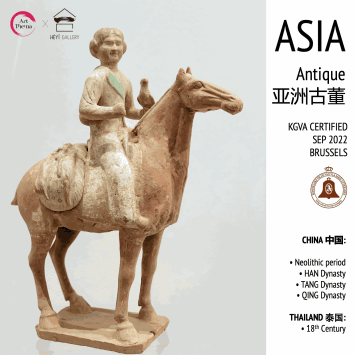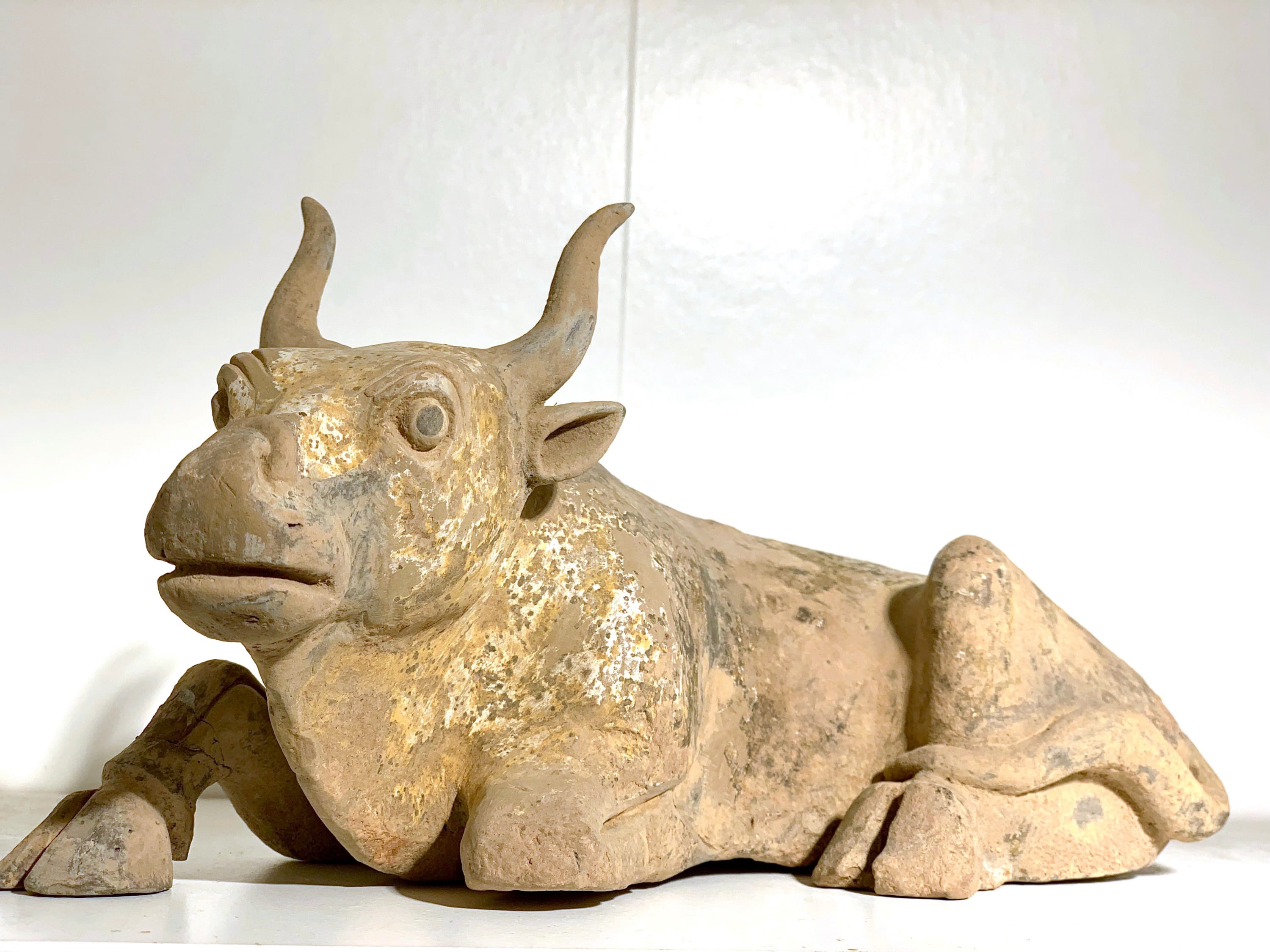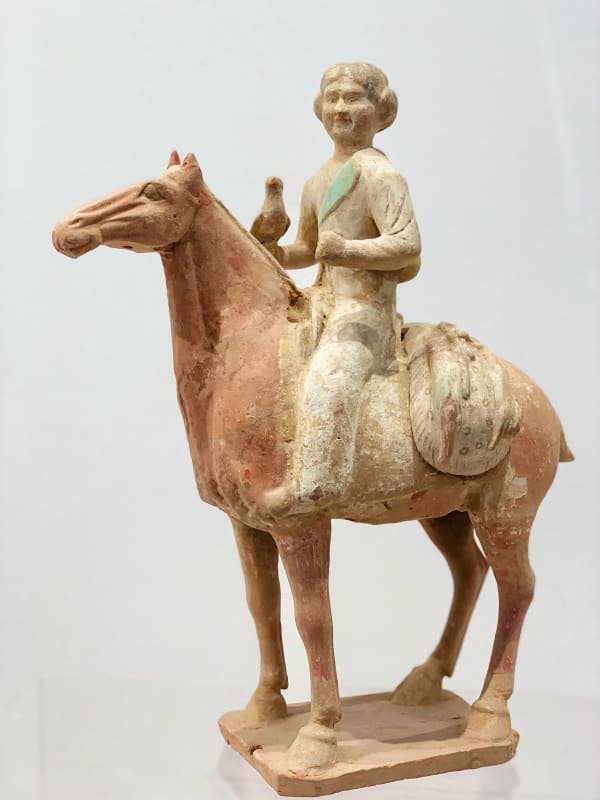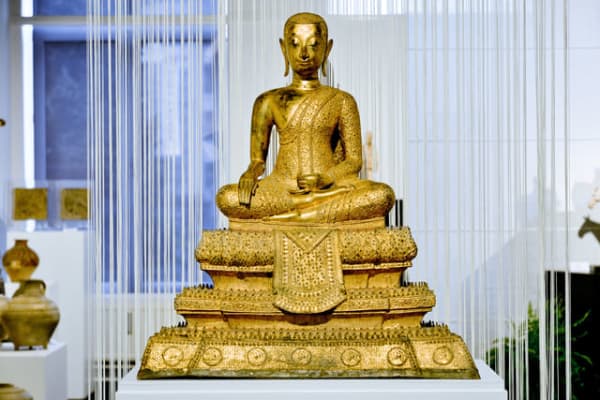A magnificent travel to Far East, beyond time and space, from today to old times...
> WHAT : 20 antiques of rare quality from China and South Asia
> PERIODS:
- CHINA (Neolitic, Han Dynasty, Northern Qi Dynasty, Tang Dynasty, Song Dynasty, Yuan Dynasty, Qing Dynasty )
- THAILAND (18th Century)
- BURMA (Early 20th Century)
> OBJECTS: Potteries, Buddhas, stone sculptures, wood art, furnitures, etc...
> WHEN: 01/09 - 23/09/2022
> WHERE: ART YI, 59 Rue de la Madeleine, 1000, Brussels, Belgium
-

-
CHINA
-
-
HAN DYNASTY
206 B.C. TO 222 A.D. -
-
Han Dynasty - The 1st Golden Age & 1st Silk Road
Art, culture, literature, philosophy, politic and economy were flourished during this period.
• The sculpture art of the Han dynasty is characterized by strong reality, and it has truly and vividly shaped various figures and social conditions. The modeling techniques of the pottery figurines of the Western Han Dynasty are simple, lively, without cumbersome frills, and under the large outline, the details are handled just right.• The boundaries maintained by the Han have more or less defined the nation of China up to the present day.• After the civil war that followed the death of Qin Shihuang in 210 B.C., China was reunited under the rule of the Han dynasty, which is divided into two major periods: the Western or Former Han (206 B.C.–9 A.D.) and the Eastern or Later Han (25–220 A.D.).The Western Han capital, Chang’an in present-day Shaanxi Province—a monumental urban center laid out on a north-south axis with palaces, residential wards, and two bustling market areas—was one of the two largest cities in the ancient world (Rome was the other).• The conquest of Ferghana and neighboring regions in 101 B.C., which allowed the Han to seize a large number of the “heavenly” long-legged horses valued for cavalry maneuvers, also gave China control of the trade routes running north and south of the Taklamakan Desert. In return for its silk and gold, China received wine, spices, woolen fabrics, grapes, pomegranates, sesame, broad beans, and alfafa.• A generation later, China flourished again under the Eastern Han dynasty (25–220 A.D.), which ruled from Luoyang, a new capital farther east in present-day Henan Province. Organized around a north-south axis and covering an area of approximately four square miles, the city was dominated by two enormous palace complexes, each 125 acres and linked by a covered pathway. -
THE HAN CHINESE
-
NORTHEN QI - A Short Revival Period ruled by Xianbei
It ruled the eastern part of northern China from 550 to 577, associated with a mix culture of Xianbei nomads, the Buddihism and the Persia.
• Northen Qi was a Chinese imperial dynasty and one of the Northern dynasties, founded by a ruler of mixed Han/Xianbei origin, strongly asserted their Xianbei nomads ethnic cultural identity.• Northern Qi potteries ceramics mark a revival of Chinese ceramic art, following the disastrous invasions and the social chaos of the 4th century. Northern Qi tombs have revealed some beautiful artifacts.• Northern Qi was the strongest state out of the three main states (the other two being Northern Zhou state and Chen Dynasty) in China when Chen was established.• The Northern Qi dynasty was ruled from a capital at Ye (presentday Linzhang) in southern Hebei province.• A Chinese scholar translated the Buddhist text Nirvana Sutra text into a Turkic language during this era. Some Zoroastrianism influences that went into previous states continued onto the state of Northern Qi court, such as the love for Persian dogs (sacred in Zoroastrianism) as they were taken as pets by nobles and eunuchs. The Chinese utilized a number of Persian artifacts and products. -
 Chinese Antiques 中国古董A Painted Pottery Laying Ox 中国北齐彩彩陶牛, Northern QI dynasty 550- 577 ADPottery, in rare and short period of Northern Qi
Chinese Antiques 中国古董A Painted Pottery Laying Ox 中国北齐彩彩陶牛, Northern QI dynasty 550- 577 ADPottery, in rare and short period of Northern Qi
Origin: China13 x 28 x 17 cm
5 1/8 x 11 x 6 3/4 inUnque Piece• Thermoluminescence Test Certificate from a scientific laboratory to the date above 1600 - 1700 years ago
• Certificate of Authenticity issued from an antique member of the Royal Guild of Flemish Antique Dealers (KGVA) for a mark of unquestionable quality
• Original Belgian Private Collection
• Free Worldwide Art Shipping (DDU)
• Professional Art Packing
• Full Insurance & Gallery Guarantee
• Certificate of Authenticity by Artist & Gallery
• Enquire a Welcome Offer for your 1st Collection -
TANG DYNASTY
618 A.D. TO 906 A.D. -
TANG DYNASTY - One of the greatest cosmopolitan dynasty with open, diverse and integrated culture
Tang Dynasty is considered as one of the greatest imperial dynasty of China with flourished open-minded culture, art, poetry, calligrpahy and tradition that influenced over East Asia until today.• Marked by strong and benevolent rule, successful diplomatic relationships, economic expansion, and a cultural efflorescence of cosmopolitan style, Tang China emerged as one of the greatest empires in the medieval world. Merchants, clerics, and envoys from India, Persia, Arabia, Syria, Korea, and Japan thronged the streets of Chang’an, the capital, and foreign tongues were a common part of daily life.• It is rightfully ranked as the classical period of Chinese art and literature, as it set the high standard to which later poets, painters, and sculptors aspired.• It was the only dynasty that allowed women to wear brightly colored open-chested clothes and also go out freely on outings and hikes on horses.• This powerful dynasty raised professional and conscripted armies of hundreds of thousands of troops to contend with nomadic powers for control of Inner Asia and the lucrative trade-routes along the Silk Road.• The potteries of court women on horses, war horses and figurines, or in rare pair from the Tang Dynasty have extremely high artistic value and are highly sought after in art investment. They are not only a perfect integration of strength and beauty, but also reflects the prosperous period of the Tang Dynasty.• Pottery antiques and Sancai ceramics are skillfully modeled and sculpted and have excellent colorful detailing.The firing process of pottery antiques is extremely sophisticated. -
"The Night Banquet in the Tang Imperial Palace"
Chinese Tang Dynasty classical dance -
 Chinese Antiques 中国古董A Pair of Painted Pottery Figure of A Fat Lady Equestrian 一对中国唐代侍女骑马彩陶, Tang Dynasty, 618 A.D. to 906 A.D., 7th century 2nd halfPottery in tri-color pigments
Chinese Antiques 中国古董A Pair of Painted Pottery Figure of A Fat Lady Equestrian 一对中国唐代侍女骑马彩陶, Tang Dynasty, 618 A.D. to 906 A.D., 7th century 2nd halfPottery in tri-color pigments
Origin: ShanXi province, China32 x 27 x 10 cm
12 5/8 x 10 5/8 x 4 inUnque Piece• Thermoluminescence Test Certificate from a German laboratory to the date above 800 - 1200 years ago
• Certificate of Authenticity issued from an antique member of the Royal Guild of Flemish Antique Dealers (KGVA) for a mark of unquestionable quality
• Original Belgian Private Collection
• Free Worldwide Art Shipping (DDU)
• Professional Art Packing
• Full Insurance & Gallery Guarantee
• Certificate of Authenticity by Artist & Gallery
• Enquire a Welcome Offer for your 1st Collection -
Horse Culture
-
SONG DYNASTY
960 – 1279 AD -
SONG DYNASTY - THE HIGHTEST AESTHETIC ATTAINMENTS IN ANCIENT CHINA
Song society was characterized by the pursuit of a highly aestheticized way of life.
• The art of the period often focus on evanescent pleasures and the transience of beauty. Images evoke poetic ideas that appeal to the senses or capture the fleeting qualities of a moment in time.• This is related to the concept of fertility that advocates more children and more blessings, which is deeply rooted in the people as a social thought. As a kind of cultural representation, the baby play map also fully reflects the exquisite sculpture skills of the Song people and the aesthetic pursuit of "shangzhen".• The Southern Song Imperial Art Academy continued the stylistic direction and high technical standards established by Emperor Huizong in the early twelfth century.• One particularly important source of inspiration for Southern Song artists was the natural beauty of Hangzhou and its environs, especially West Lake of lotus flowers, a famed scenic spot ringed with lush mountains and dotted with palaces, private gardens, and Buddhist temples.• The artistic expression of the Song Dynasty baby opera theme focuses on the depiction of daily life, which mostly reflects a plain, peaceful and intimate feeling, without pretense and exaggeration, and is full of rich life flavor. -
 Chinese Antiques 中国古董A Pair of earthenware stone brick sculptures of child holding lotus flower, China 中国宋代荷塘婴戏图石雕, SONG dynasty 960 – 1279 ADOrigin: China
Chinese Antiques 中国古董A Pair of earthenware stone brick sculptures of child holding lotus flower, China 中国宋代荷塘婴戏图石雕, SONG dynasty 960 – 1279 ADOrigin: China
Mounted on a black metal footStone alone : 22,5 x 41 x 10 cm
Total dimension : 32 x 46 x 15 cmUnque Piece, Sell in a pair of two• Certificate of Authenticity issued from an antique member of the Royal Guild of Flemish Antique Dealers (KGVA) for a mark of unquestionable quality
• Original Belgian Private Collection
• Free Worldwide Art Shipping (DDU)
• Professional Art Packing
• Full Insurance & Gallery Guarantee
• Certificate of Authenticity by Artist & Gallery
• Enquire a Welcome Offer for your 1st Collection -
YUAN DYNASTY
1271- 1368 AD -
YUAN DYNASTY - Fusion of Mongolian nomadic culture
For the first time in its long history—was completely subjugated by foreign conquerors and became part of a larger political entity, the vast Mongol empire.
• Ruling from their capital in Dadu (also known as Khanbaliq; now Beijing), the Mongol Khans increasingly assumed the role of Chinese emperors.• Fu Dogs are also sometimes acknowledged by their innate qualities or abilities: and an auspicious lion is Ruishi, a fortuitous lion is Fushi, while the Lion of Buddha is Foshi.• Southern Chinese, having resisted the Mongol invasion the longest, faced a conscious policy of discrimination, leading many scholars to withdraw from public life to pursue their own personal and artistic cultivation, often under the aegis of the Buddhist or Daoist religions.
• The concept of Fu Dog, which originated and became popular in Chinese Buddhism, features a pair of highly stylized lions —often one male with a ball which represents the material elements and one female with a cub—which represents the element of spirit , were thought to protect the building from harmful spiritual influences and harmful people that might be a threat. Used in imperial Chinese palaces and tombs, the lions subsequently spread to other parts of Asia. -
 Chinese Antiques 中国古董A Pair of earthenware stone brick sculptures of FU Dogs, China 中国元代福狮石雕, Yuan dynasty 1271- 1368 ADOrigin: China
Chinese Antiques 中国古董A Pair of earthenware stone brick sculptures of FU Dogs, China 中国元代福狮石雕, Yuan dynasty 1271- 1368 ADOrigin: China
Mounted in a plexi frame
Can either hang on wall, or place on standStone alone : 22 x 30 x 6 cm
Total dimension : 35 x 42 x 7 cmUnque Piece, Sell in a pair of two• Certificate of Authenticity issued from an antique member of the Royal Guild of Flemish Antique Dealers (KGVA) for a mark of unquestionable quality
• Original Belgian Private Collection
• Free Worldwide Art Shipping (DDU)
• Professional Art Packing
• Full Insurance & Gallery Guarantee
• Certificate of Authenticity by Artist & Gallery
• Enquire a Welcome Offer for your 1st Collection -
QING DYNASTY
1636 - 1912 AD -
QING DYNASTY - the Manchus embraced Chinese cultural traditions
A development of Chinese fine art and traditional furnitures of highest sophisticity in this new combined culture
• In 1644, the Manchus, a semi-nomadic people from northeast of the Great Wall, conquered the crumbling Ming state and established their own Qing (or Pure) dynasty, which lasted nearly 300 years.• China's top antique furniture was made in the last two dynasties of Ming Dynasty (1368-1644) and Qing Dynasty (1644-1912) furniture, using Hall or Chamber Furniture to highlight the reasons for changes in the general style and materials used.• During the first half of this period, the Manchus extended their rule over a vast empire that grew to encompass new territories in Central Asia, Tibet, and Siberia. The Manchus also established their hegemony over Chinese cultural traditions as an important means of demonstrating their legitimacy as Confucian-style rulers.• The main similarity over the two dynasties was the superb craftsmanship. Also, the best wood available was always used, regardless of future consequences for the environment. Because the best timber was used by the best craftsman, pieces from these eras survived the test of time and are still desirable today.
• In the later Qing Era furniture was bigger in size. With greatness, pomp, and almost gaudy embellishments, carvings are elaborate and featured fashionable openwork.• Dovetailing was another method used to join wood (imagine interlocking fingers). Nowadays both joints are still used on quality furnishings. The importance of these joints are that they are simple, strong and because of the perfect fit with no glue needed, the wood can expand and contract according to humidity. -
THAILAND
-
BURMA
-
 Thailand Antiques 泰国古董Burma Marble Buddha 缅甸大理石佛像, Early 20th CenturyMarble44 x 32 x 19 cm
Thailand Antiques 泰国古董Burma Marble Buddha 缅甸大理石佛像, Early 20th CenturyMarble44 x 32 x 19 cm
17 3/8 x 12 5/8 x 7 1/2 inUnque Piece• Certificate of Authenticity issued from an antique member of the Royal Guild of Flemish Antique Dealers (KGVA) for a mark of unquestionable quality
• Original Belgian Private Collection
• Free Worldwide Art Shipping (DDU)
• Professional Art Packing
• Full Insurance & Gallery Guarantee
• Certificate of Authenticity by Artist & Gallery
• Enquire a Welcome Offer for your 1st Collection -
ART YĪ












